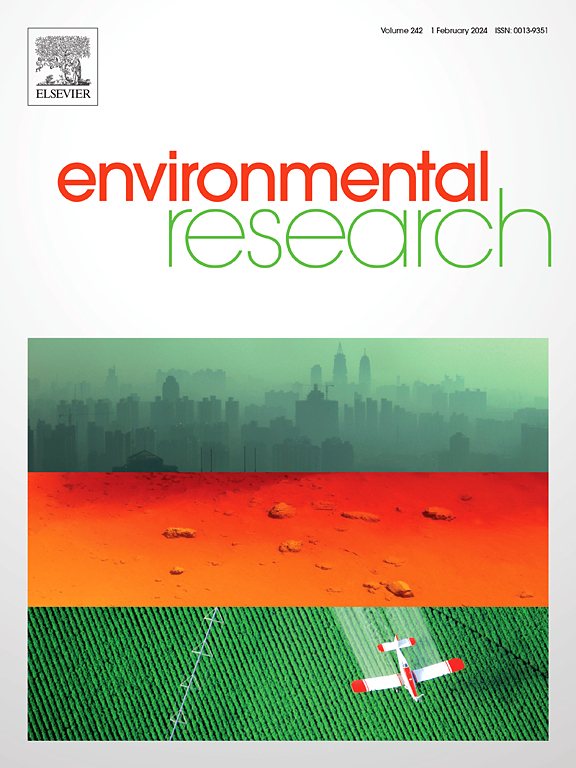欧洲河流中新出现的有机污染物的季节性变化和风险评估:将计算机和体外方法联系起来,优先考虑有害的有机污染物。
IF 7.7
2区 环境科学与生态学
Q1 ENVIRONMENTAL SCIENCES
引用次数: 0
摘要
新兴有机污染物(EOCs)是水生生态系统日益关注的问题,强调需要先进的风险评估方法。本研究采用综合方法评估克罗地亚萨瓦河沿岸13个监测点的563种生态环境污染相关风险。采样是在冬季和春季进行的,从2月到5月。检出的物质共551种化合物,包括药物、非法药物、杀虫剂、工业化学品、激素、人造甜味剂和防晒化学品。我们假设,将高分辨率化学监测与生物效应评估工具相结合,可以提高高风险EOCs及其混合物的优先级。持久性、生物蓄积性和毒性(PBT)分析和风险商(RQ)评估确定农药和工业化学品是生物影响的主要贡献者,由于农业活动,4月份达到峰值。利用来自ToxCast数据库的暴露-活性比(ear)进行的体外优先排序显示,在寒冷的月份(2月和3月),由于药物水平升高,特别是用于治疗呼吸道感染的合成糖皮质激素水平升高,生物效应加剧。通过综合PBT、RQ和EAR评估,将甲基强的松龙(一种合成糖皮质激素)、双酚a(一种工业化学品)、尼古丁(一种兴奋剂)和五种农药(双硫磷、二硫磷、嘧螨虫、联苯菊酯和甲基毒死蜱)等八种EOCs列为监测和监管重点。这种多方法框架推进了下一代风险评估,为管理EOC污染和保护水生生态系统和公众健康提供了重要见解。本文章由计算机程序翻译,如有差异,请以英文原文为准。

Seasonal variability and risk evaluation of emerging organic contaminants in European river: Linking in silico and in vitro approaches to prioritize hazardous EOCs
Emerging organic contaminants (EOCs) are a growing concern for aquatic ecosystems, underscoring the need for advanced risk assessment methodologies. This study employed an integrated approach to evaluate the risks associated with 563 EOCs across 13 monitoring sites along the Sava River in Croatia. Sampling was conducted during the winter and spring months, spanning February to May. The detected substances, totaling 551 compounds, included pharmaceuticals, illicit drugs, pesticides, industrial chemicals, hormones, artificial sweetener, and sunscreen chemical. We hypothesized that combining high-resolution chemical monitoring with bio-effect assessment tools could enhance the prioritization of high-risk EOCs and their mixtures.
Persistent, bioaccumulative, and toxic (PBT) profiling and risk quotient (RQ) evaluations identified pesticides and industrial chemicals as key contributors to biological impacts, peaking in April due to agricultural activities. In vitro prioritization using exposure-activity ratios (EARs) derived from the ToxCast database revealed exacerbated biological effects during colder months (February and March), driven by elevated levels of pharmaceuticals, particularly synthetic glucocorticoids used for treatments of respiratory infections.
By integrating PBT, RQ, and EAR assessments, eight EOCs, including methylprednisolone (a synthetic glucocorticoid), bisphenol A (an industrial chemical), nicotine (a stimulant), and five pesticides (temephos, disulfoton, pyridaben, bifenthrin, and chlorpyrifos-methyl), were prioritized for monitoring and regulatory attention. This multi-method framework advances next-generation risk assessment, offering critical insights for managing EOC pollution and safeguarding aquatic ecosystems and public health.
求助全文
通过发布文献求助,成功后即可免费获取论文全文。
去求助
来源期刊

Environmental Research
环境科学-公共卫生、环境卫生与职业卫生
CiteScore
12.60
自引率
8.40%
发文量
2480
审稿时长
4.7 months
期刊介绍:
The Environmental Research journal presents a broad range of interdisciplinary research, focused on addressing worldwide environmental concerns and featuring innovative findings. Our publication strives to explore relevant anthropogenic issues across various environmental sectors, showcasing practical applications in real-life settings.
 求助内容:
求助内容: 应助结果提醒方式:
应助结果提醒方式:


